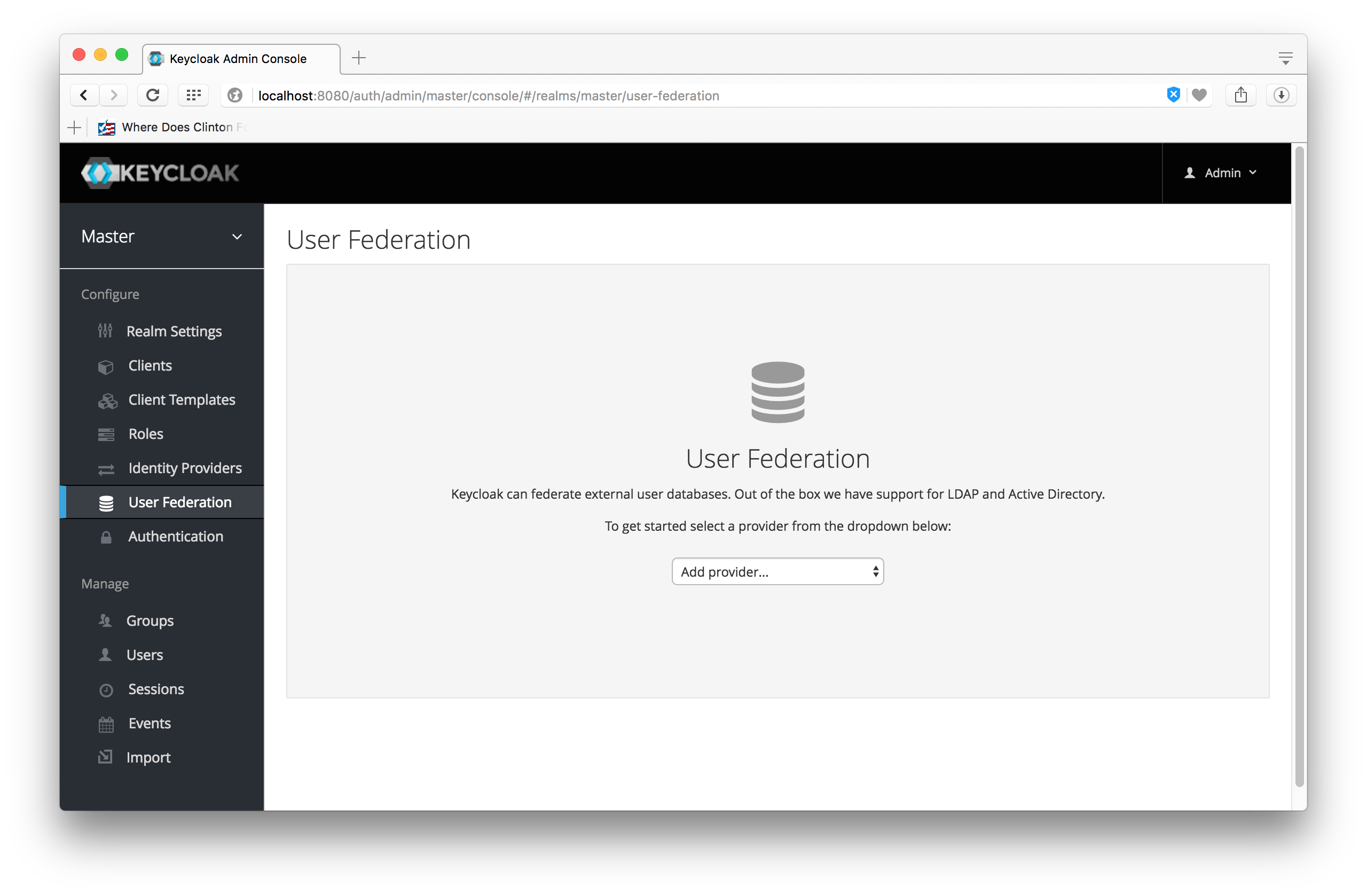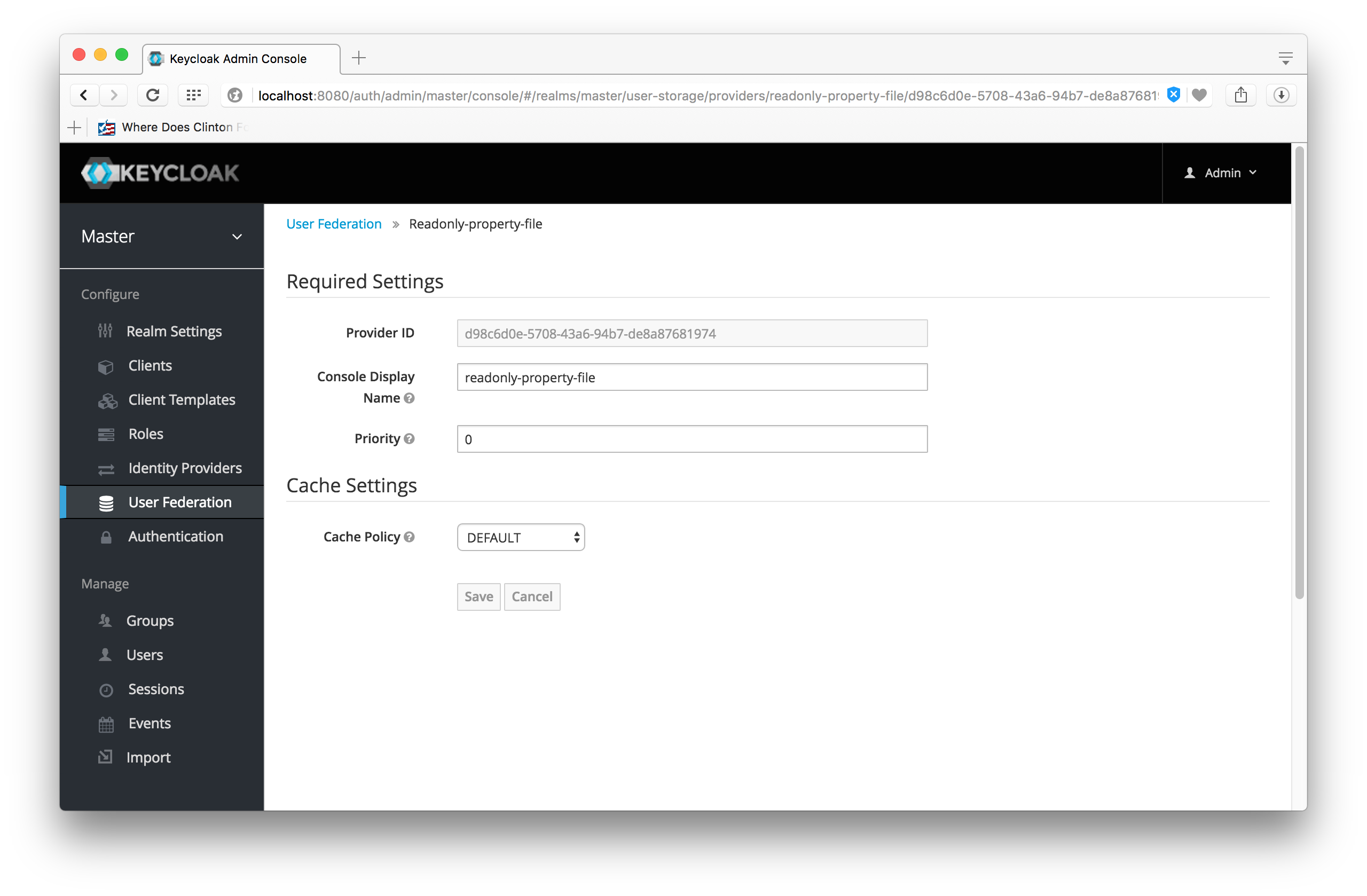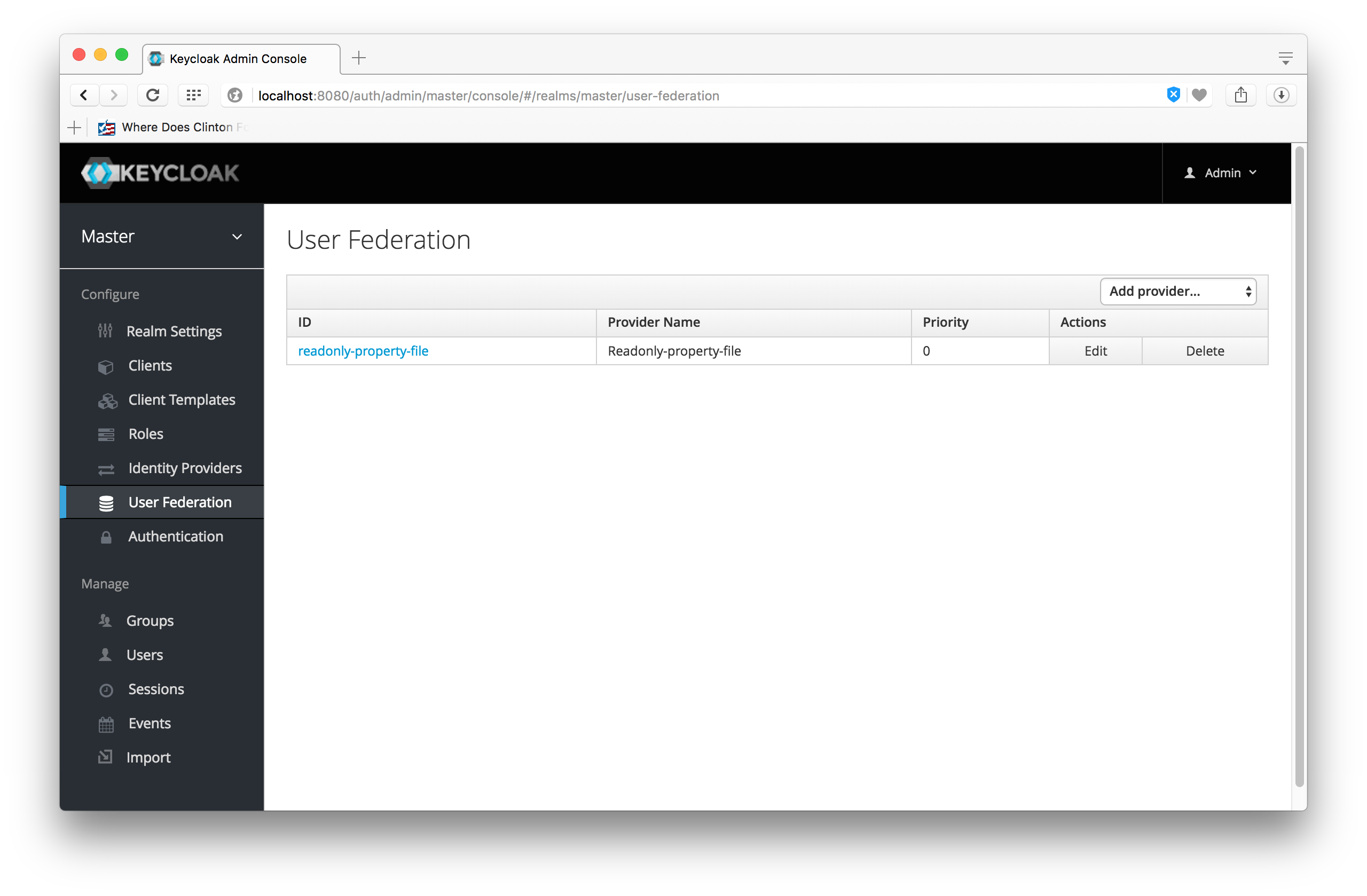public class PropertyFileUserStorageProvider implements
UserStorageProvider,
UserLookupProvider,
CredentialInputValidator,
CredentialInputUpdater
{
...
}Simple Read-Only, Lookup Example
To illustrate the basics of implementing the User Storage SPI let’s walk through a simple example. In this chapter you’ll see the implementation of a simple UserStorageProvider that looks up users in a simple property file. The property file contains username and password definitions and is hardcoded to a specific location on the classpath. The provider will be able to look up the user by ID and username and also be able to validate passwords. Users that originate from this provider will be read-only.
Provider Class
The first thing we will walk through is the UserStorageProvider class.
Our provider class, PropertyFileUserStorageProvider, implements many interfaces. It implements the UserStorageProvider as that is a base requirement of the SPI. It implements the UserLookupProvider interface because we want to be able to log in with users stored by this provider. It implements the CredentialInputValidator interface because we want to be able to validate passwords entered in using the login screen. Our property file is read-only. We implement the CredentialInputUpdater because we want to post an error condition when the user attempts to update his password.
protected KeycloakSession session;
protected Properties properties;
protected ComponentModel model;
// map of loaded users in this transaction
protected Map<String, UserModel> loadedUsers = new HashMap<>();
public PropertyFileUserStorageProvider(KeycloakSession session, ComponentModel model, Properties properties) {
this.session = session;
this.model = model;
this.properties = properties;
}The constructor for this provider class is going to store the reference to the KeycloakSession, ComponentModel, and property file. We’ll use all of these later. Also notice that there is a map of loaded users. Whenever we find a user we will store it in this map so that we avoid re-creating it again within the same transaction. This is a good practice to follow as many providers will need to do this (that is, any provider that integrates with JPA). Remember also that provider class instances are created once per transaction and are closed after the transaction completes.
UserLookupProvider Implementation
@Override
public UserModel getUserByUsername(String username, RealmModel realm) {
UserModel adapter = loadedUsers.get(username);
if (adapter == null) {
String password = properties.getProperty(username);
if (password != null) {
adapter = createAdapter(realm, username);
loadedUsers.put(username, adapter);
}
}
return adapter;
}
protected UserModel createAdapter(RealmModel realm, String username) {
return new AbstractUserAdapter(session, realm, model) {
@Override
public String getUsername() {
return username;
}
};
}
@Override
public UserModel getUserById(String id, RealmModel realm) {
StorageId storageId = new StorageId(id);
String username = storageId.getExternalId();
return getUserByUsername(username, realm);
}
@Override
public UserModel getUserByEmail(String email, RealmModel realm) {
return null;
}The getUserByUsername() method is invoked by the Keycloak login page when a user logs in. In our implementation we first check the loadedUsers map to see if the user has already been loaded within this transaction. If it hasn’t been loaded we look in the property file for the username. If it exists we create an implementation of UserModel, store it in loadedUsers for future reference, and return this instance.
The createAdapter() method uses the helper class org.keycloak.storage.adapter.AbstractUserAdapter. This provides a base implementation for UserModel. It automatically generates a user id based on the required storage id format using the username of the user as the external id.
"f:" + component id + ":" + username
Every get method of AbstractUserAdapter either returns null or empty collections. However, methods that return role and group mappings will return the default roles and groups configured for the realm for every user. Every set method of AbstractUserAdapter will throw a org.keycloak.storage.ReadOnlyException. So if you attempt to modify the user in the admininstration console, you will get an error.
The getUserById() method parses the id parameter using the org.keycloak.storage.StorageId' helper class. The `StorageId.getExternalId() method is invoked to obtain the username embeded in the id parameter. The method then delegates to getUserByUsername().
Emails are not stored, so the getUserByEmail() method returns null.
CredentialInputValidator Implementation
Next let’s look at the method implementations for CredentialInputValidator.
@Override
public boolean isConfiguredFor(RealmModel realm, UserModel user, String credentialType) {
String password = properties.getProperty(user.getUsername());
return credentialType.equals(CredentialModel.PASSWORD) && password != null;
}
@Override
public boolean supportsCredentialType(String credentialType) {
return credentialType.equals(CredentialModel.PASSWORD);
}
@Override
public boolean isValid(RealmModel realm, UserModel user, CredentialInput input) {
if (!supportsCredentialType(input.getType()) || !(input instanceof UserCredentialModel)) return false;
UserCredentialModel cred = (UserCredentialModel)input;
String password = properties.getProperty(user.getUsername());
if (password == null) return false;
return password.equals(cred.getValue());
}The isConfiguredFor() method is called by the runtime to determine if a specific credential type is configured for the user. This method checks to see that the password is set for the user.
The suportsCredentialType() method returns whether validation is supported for a specific credential type. We check to see if the credential type is password.
The isValid() method is responsible for validating passwords. The CredentialInput parameter is really just an abstract interface for all credential types. We make sure that we support the credential type and also that it is an instance of UserCredentialModel. When a user logs in through the login page, the plain text of the password input is put into an instance of UserCredentialModel. The isValid() method checks this value against the plain text password stored in the properties file. A return value of true means the password is valid.
CredentialInputUpdater Implementation
As noted before, the only reason we implement the CredentialInputUpdater interface in this example is to forbid modifications of user passwords. The reason we have to do this is because otherwise the runtime would allow the password to be overriden in Keycloak local storage. We’ll talk more about this later in this chapter.
@Override
public boolean updateCredential(RealmModel realm, UserModel user, CredentialInput input) {
if (input.getType().equals(CredentialModel.PASSWORD)) throw new ReadOnlyException("user is read only for this update");
return false;
}
@Override
public void disableCredentialType(RealmModel realm, UserModel user, String credentialType) {
}
@Override
public Set<String> getDisableableCredentialTypes(RealmModel realm, UserModel user) {
return Collections.EMPTY_SET;
}The updateCredential() method just checks to see if the credential type is password. If it is, a ReadOnlyException is thrown.
Provider Factory Implementation
Now that the provider class is complete, we now turn our attention to the provider factory class.
public class PropertyFileUserStorageProviderFactory
implements UserStorageProviderFactory<PropertyFileUserStorageProvider> {
public static final String PROVIDER_NAME = "readonly-property-file";
@Override
public String getId() {
return PROVIDER_NAME;
}First thing to notice is that when implementing the UserStorageProviderFactory class, you must pass in the concrete provider class implementation as a template parameter. Here we specify the provider class we defined before: PropertyFileUserStorageProvider.
|
Warning
|
If you do not specify the template parameter, your provider will not function. The runtime does class introspection to determine the capability interfaces that the provider implements. |
The getId() method identifies the factory in the runtime and will also be the string shown in the admin console when you want to enable a user storage provider for the realm.
Initialization
private static final Logger logger = Logger.getLogger(PropertyFileUserStorageProviderFactory.class);
protected Properties properties = new Properties();
@Override
public void init(Config.Scope config) {
InputStream is = getClass().getClassLoader().getResourceAsStream("/users.properties");
if (is == null) {
logger.warn("Could not find users.properties in classpath");
} else {
try {
properties.load(is);
} catch (IOException ex) {
logger.error("Failed to load users.properties file", ex);
}
}
}
@Override
public PropertyFileUserStorageProvider create(KeycloakSession session, ComponentModel model) {
return new PropertyFileUserStorageProvider(session, model, properties);
}The UserStorageProviderFactory interface has an optional init() method you can implement. When Keycloak boots up, only one instance of each provider factory is created. Also at boot time, the init() method is called on each of these factory instances. There’s also a postInit() method you can implement as well. After each factory’s init() method is invoked, their postInit() methods are called.
In our init() method implementation, we find the property file containing our user declarations from the classpath. We then load the properties field with the username and password combinations stored there.
The Config.Scope parameter is factory configuration that can be set up within standalone.xml, standalone-ha.xml, or domain.xml. For more information on where the standalone.xml, standalone-ha.xml, or domain.xml file resides see the Server Installation and Configuration.
For example, by adding the following to standalone.xml:
<spi name="storage">
<provider name="readonly-property-file" enabled="true">
<properties>
<property name="path" value="/other-users.properties"/>
</properties>
</provider>
</spi>We can specify the classpath of the user property file instead of hardcoding it. Then you can retrieve the configuration in the PropertyFileUserStorageProviderFactory.init():
public void init(Config.Scope config) {
String path = config.get("path");
InputStream is = getClass().getClassLoader().getResourceAsStream(path);
...
}Create Method
Our last step in creating the provider factory is the create() method.
@Override
public PropertyFileUserStorageProvider create(KeycloakSession session, ComponentModel model) {
return new PropertyFileUserStorageProvider(session, model, properties);
}We simply allocate the PropertyFileUserStorageProvider class. This create method will be called once per transaction.
Packaging and Deployment
The class files for our provider implementation should be placed in a jar. You also have to declare the provider factory class within the META-INF/services/org.keycloak.storage.UserStorageProviderFactory file.
org.keycloak.examples.federation.properties.FilePropertiesStorageFactory
Once you create the jar you can deploy it using regular JBoss/Wildfly means: copy the jar into the deploy/ directory or using the JBoss CLI.
Enabling the Provider in the Administration Console
You enable user storage providers per realm within the User Federation page in the administration console.

Select the provider we just created from the list: readonly-property-file. It brings you to the configuration page for our provider. We do not have anything to configure, so click Save.

When you go back to the main User Federation page, you now see your provider listed.

You will now be able to log in with a user declared in the users.properties file. This user will only be able to view the account page after logging in.